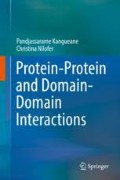Abstract
Protein-protein binding is associated with catalysis, regulation, immune response, and inhibition. The binding of identical subunits forming homodimers is interesting. The folding and binding of homodimers are further intriguing. There are 2-state (2S) and 3-state (3S) homodimer complexes where 3SMI with monomer intermediate and 3SDI with dimer intermediate exit. We describe some of the characteristic features of 2S and 3S homodimer folding and binding in this chapter.
Access this chapter
Tax calculation will be finalised at checkout
Purchases are for personal use only
References
Lulu S, Suresh A, Karthikraja V, Arumugam M, Kayathri R, Kangueane P. Structural features for homodimer folding mechanism. J Mol Graph Model. 2009;28(2):88–94.
Suresh A, Karthikraja V, Lulu S, Kangueane U, Kangueane P. A decision tree model for the prediction of homodimer folding mechanism. Bioinformation. 2009;4(5):197–205.
Karthikraja V, Suresh A, Lulu S, Kangueane U, Kangueane P. Types of interfaces for homodimer folding and binding. Bioinformation. 2009;4(3):101–11.
Li L, et al. Structural features differentiate the mechanisms between 2S (2 state) and 3S (3 state) folding homodimers. Bioinformation. 2005;1(2):42–9.
Author information
Authors and Affiliations
Exercises
Exercises
-
1.
Illustrate the three states of homodimer folding.
-
2.
Show the distribution of interface area to monomer size for all the three states of homodimers.
-
3.
Illustrate a homodimer using an example.
-
4.
Illustrate the difference in the three states of homodimers using structures.
-
5.
Show the distribution of the ratio of interface to monomer size using a suitable chart.
-
6.
Illustrate large, medium, and small homodimer interfaces using diagrams.
-
7.
State the experiment used for studying homodimer folding.
-
8.
What are the three states of homodimer folding?
-
9.
What are the usual molecular functions associated with 2S, 3SMI, and 3SDI homodimers?
Rights and permissions
Copyright information
© 2018 Springer Nature Singapore Pte Ltd.
About this chapter
Cite this chapter
Kangueane, P., Nilofer, C. (2018). Homodimer Protein Folding and Binding. In: Protein-Protein and Domain-Domain Interactions. Springer, Singapore. https://doi.org/10.1007/978-981-10-7347-2_10
Download citation
DOI: https://doi.org/10.1007/978-981-10-7347-2_10
Published:
Publisher Name: Springer, Singapore
Print ISBN: 978-981-10-7346-5
Online ISBN: 978-981-10-7347-2
eBook Packages: Biomedical and Life SciencesBiomedical and Life Sciences (R0)

